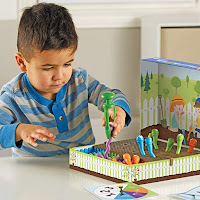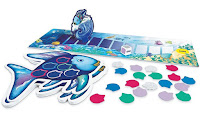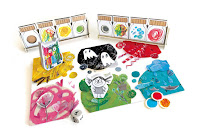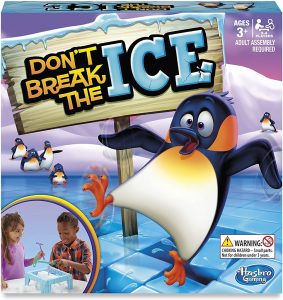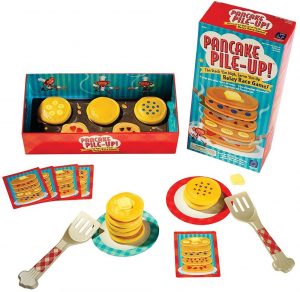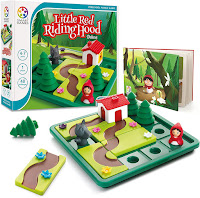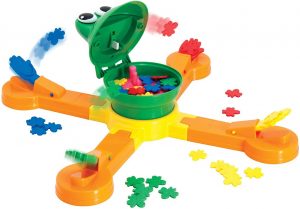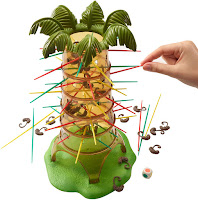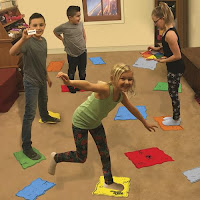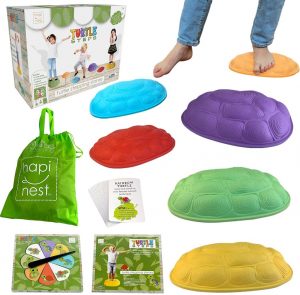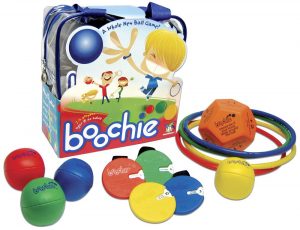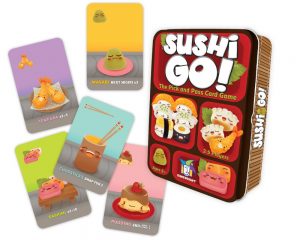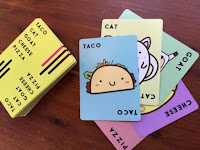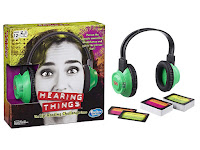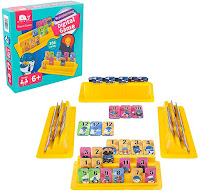Winter always means more indoor times and with concerns about another wave of Covid-19 cases as we enter the holiday season, I anticipate people will be spending a lot more time indoors as a family. There are only so many television shows one can binge and I get the sense that people are looking for ways to connect that don’t involve a screen given amount of time people are spending with remote learning and work. Now seems like an ideal time to re-evaluate your game closet and make sure you have some games that will keep the whole family entertained. Below, I share a handful of this year’s favorites. I am excited to have some amazing game suggestions from my colleague, speech therapist Jacki Barredo, that are geared towards older kids and have a speech and language twist to them. I have also tried to add a handful of board games that encourage movement as I think it’s so important that no matter what happens with the pandemic, we keep kids active because it is proven that children learn better and are more emotionally balanced when their bodies are given the opportunity to get up and move.
Wriggleworms-I am a complete sucker for any game that has some kind of grabber to pick up pieces so when I saw this game I was sold. For the little ones on your gift list this year, this is a simple game packed with fun ways to work on developing a variety of skills. The game comes with 20 stretchy worms in 4 colors and 2 different lengths and 20 cards (10 with numbers, 8 critical thinking and 2 size outlines). Kids spin a spinner and they either collect a worm of the same color or the number of worms that they land on. The goal of the game is to be the player to collect the larger number of worms. My favorite part is that they have to use the provided tongs to remove the worms from the game board which is a wonderful way to work on increasing grasp strength and improve manipulation skills. In addition to working on fine motor skills, children learn about colors and size, can practice working on sorting skills, counting and be introduced to early math skills.
Share And Sparkle Game-The Rainbow Fish is a popular children’s book that teaches children about the importance of being kind, sharing and what it means to be a good friend. In this cooperative, educational game, children must work together to collect all of the Rainbow Fish’s sparkly scales so he can swim in the waves before they reach the shore. Cooperative games are a great way for children or families to learn that there is more to playing a game than winning or losing. In addition to working on improving play skills, children can work on developing fine motor and grasping skills, hand-eye coordination and visual perceptual skills.
The Color Monster Game-based on one of my favorite children’s books about learning how to identify and understand feelings, The Color Monster game seems to be a much needed resources for young children during these crazy times. Children (and their grownups!) are feeling lot of big feelings and sometimes that can be very confusing. In this collaborative game, children work take turns rolling the dice to move the monster around the board to try and fill up the jars by matching the emotion tokens to the correct colored jar. In order to pick up an emotion coin, children have to share a memory or experience they had with whichever feeling they pick up (Happiness, Sadness, Anger, Fear or Calm). The game is finished when all the correct emotion tokens are in the correct jar.
Don’t Break The Ice-a classic children’s game perfect for preschoolers, Don’t Break the Ice is a two to four player game where the object is to keep Phillip the Penguin on top of the ice as long as you can while you tap out pieces of ice. Using a little mallet, kids tap out ice pieces but it requires thought and patience to choose a piece that won’t make the whole board break. This game is perfect for the little ones in your life who are just starting to learn about turn taking. It also works on developing hand-eye coordination, bilateral coordination and can improve grasping and manipulation skills.
Pancake Pileup-this game is a huge hit both at my sensory gym and with my kids at The Meeting House. What I love about Pancake Pileup is that you can play it in so many ways depending on your child’s goals. This game has been a good one to play on my remote sessions to add a gross motor component. It is traditionally a relay-style game where kids pick a card and then try and be the first to stack their pancakes in the correct order; pancakes are on one end of the room and the plate is on the other. If you have several kids you can do a relay race where one kid picks up the first pancake, hands off the spatula to the next kid and continue until the card is complete. Pancake Pileup is great for working on improving visual perceptual skills, hand-eye coordination, sequencing and executive functioning skills such as focus, attention, organization and regulation skills. Additionally, you can improve gross motor skills by giving the kids physical challenges such as jumping, walking backwards, etc.
First Orchard-one of the things I am hearing from many of my families is their concerns about their very young children missing out on critical opportunities to socialize and learn early academic skills. I am here to reassure parents of young children that there are so many other ways to support your children during this crazy time and the most important way is through play. If your toddler isn’t going to school, collaborative games like First Orchard are great for teaching them about working together, color recognition and early counting skills. Together, children (and their grownups if necessary) work together to pick the fruits from the trees before the raven reaches the end of the path. First Orchard is similar to Hi Ho Cherry O but I am always a big fan of toys/products made from wood for sustainability. In addition to working on the aforementioned skills, First Orchard encourages fine motor and manipulations skill and hand-eye coordination.
Little Red Riding Hood Game-this is a great game to work on problem solving and logical reasoning with preschoolers and young school-age children. The point of the game is to get Little Red Riding Hood to grandma’s house by creating the correct path. There are 48-challenge cards and each one starts with a guide to how to place the pieces (Little Red Riding Hood, grandma’s house, trees and the wolf) on the board and fill in the path using the correct pieces. While they say this is a 1-player game, I think it would be a great game for kids to work on together in order to solve the challenge. In addition to cognitive skills, this game works on improving fine motor, grasping and manipulation skills, improves visual-spatial and perceptual skills and increases executive functioning skills such as focus, attention and organizational skills.
Mr. Mouth-I love when games from my childhood make a comeback and even more happy when said games end up being favorites for the kids that I work with. Mr. Mouth is great for older preschoolers and school-age kids to work on improving hand-eye coordination, visual motor and visual perceptual skills and a great game for working on executive functioning skills such as focus, attention, regulation and organizational skills. Be the first to get all of your bugs into the mouth. Sounds easy but you have to time it just right which can be tricky. For my younger kids who might be getting frustrated, I often let them practice by keeping the mouth open for the first round so they can get used to the game in order to build up their frustration tolerance.
Kerplunk Sloths-the original Kerplunk (marbles) and Tumblin’ Monkeys are two of my favorite games and also longtime favorites at work. When I went searching for the link to those games, I stumbled upon this newer version and obsessed is an understatement. Instead of marbles or monkeys, you have to collect the cutest little plastic sloths you’ve ever seen! Kids take turns rolling the die and removing the matching color stick. The rules actually say that the person with the least number of sloths at the end is the winner but I often let the child(ren) playing decide if they want to aim to get the most or the least number in order to determine a winner. Kerplunk Sloths works on so many developmental skills including improving fine motor and manipulation skills, improving visual motor and visual perceptual skills, encourages executive functioning skills such as focus, attention, planning and organizational skills. Younger children may need some assistance for set-up but in general, this game is appropriate for pre-school through school-age children.
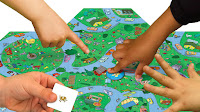 Spottington-for those of you who don’t know about Eeboo, I highly recommend you get to know them. In addition to beautiful puzzles, pretend play toys and craft supplies, they have some of the most well-made, durable and creative games. I received Spottington in my monthly Sensory TheraPlay box last month and it’s been a great game for my school age kids. One of my favorite things about this visual perceptual and visual scanning game is the fact that it comes with 7 double-sided interchangeable game boards so the game is never the same. The rules of the game are quite simple, which is another bonus, which makes it more fun for everyone. People take turns flipping over one of the 250 picture cards and everyone playing races to be the first one to find it. Once you find it, you place your token on it and call out “Spottington”. The objects are various sizes and there be others that look similar so it really takes a lot of concentration. This game is great for working on visual motor, visual scanning and visual discrimination skills and improves executive functioning skills such as focus and attention.
Spottington-for those of you who don’t know about Eeboo, I highly recommend you get to know them. In addition to beautiful puzzles, pretend play toys and craft supplies, they have some of the most well-made, durable and creative games. I received Spottington in my monthly Sensory TheraPlay box last month and it’s been a great game for my school age kids. One of my favorite things about this visual perceptual and visual scanning game is the fact that it comes with 7 double-sided interchangeable game boards so the game is never the same. The rules of the game are quite simple, which is another bonus, which makes it more fun for everyone. People take turns flipping over one of the 250 picture cards and everyone playing races to be the first one to find it. Once you find it, you place your token on it and call out “Spottington”. The objects are various sizes and there be others that look similar so it really takes a lot of concentration. This game is great for working on visual motor, visual scanning and visual discrimination skills and improves executive functioning skills such as focus and attention.
The Floor is Lava-with the recent success of the Netflix show, The Floor is Lava, this has become a game kids have gotten really into. I love this game, especially as we are looking at the possibility of a second round of lockdowns and shelter in place action, because it offers movement opportunities for our kids who are spending so much time on a screen. In this family game players must imagine that the floor is molten hot lava while spinning the color wheel to jump to the right foam pieces. The game comes with 25 different colored “safety stones” and 27 challenge cards. This gross motor game works on jumping, leaping, balance, coordination and motor planning. For younger kids, this could be a really fun way to learn about colors.
Turtle Steps-another gross motor game that can be played indoors or outdoors. Kids who have gross motor delays often want to avoid movement at all costs possible so being able to do it through game can be a game changer for them. Turtle Steps works on balance, coordination and concentration and is appropriate for children 3 years and older. The game includes 3 large and 3 medium-sized turtle shell stepping stones, 24 activity cards with turtle facts and alternative ways to play the game. Through obstacle courses and challenges, kids can work on jumping, coordination and increasing body strength. Play by the rules it comes with or create your own game using the turtle shells. For those of you worried about space, the shells easily stack as to not take up too much space. Gross motor development and movement is important for building confidence, self-esteem and helps with children learning. During these crazy times where so many kids are doing remote school, it’s so important that we provide as many opportunities for movement that we can.
Boochie-another movement game that the whole family can enjoy indoors or outdoors. The first part of the game is to toss out the Boochie target and then try to land your ball and as close as possible. Kids will love that they get to keep score on the special wrist tracker that the game comes with that will throw out different throwing challenges each round. Kids may have to toss between their legs, behind their back, with their eyes closed and so much more. In addition to getting kids up and moving while they may be stuck inside this winter, it works on improving a variety of gross motor skills such as hand-eye coordination, balance, endurance, throwing skills and so much more.
Taco Cat Goat Cheese Pizza-this game recommendation comes from speech therapist extraordinaire, Jacki Barredo. I’m a huge fan of card games because they are easy to store and can easily be taken on the go to keep your kids entertained and this definitely fits that requirement. Pass out all of the cards to all the players and take turns flipping your cards over while saying taco, cat, goat, cheese, pizza (in that order). When the card and the word match, players race to slap the cards and the winner takes the pile. Be sure to keep your eyes open for three special action cards. This is definitely for older children on your gift list and great for working on sequencing, organization, focus, attention and really great for working on regulatory skills.
Hearing Things-another recommendation from my speech therapist colleague, Jacki Barredo, geared towards older children (10 and older). After the online viral “whisper challenge” sensation, Hasbro created this game. One player puts on a pair of speech-cancelling electronic headphones and the other player is required to say the random phrases on the card. The player only earns the card if they correctly figure out what the other one was saying.
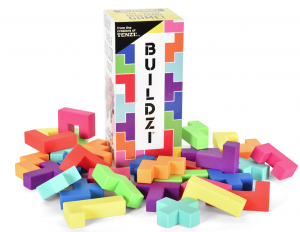 Buildzi-one of my absolute favorite games, and has been for years, is the dice game Tenzi. It’s been a favorite for my kids and has been on my gift guide for years. As I have spent the last few months trying to freshen up my game selection, I stumbled on Buildzi and had to test it out immediately. It has quickly become a favorite of my kids, particularly my older children. One of the things that I love about this companies games is that they all have more than one way to play it making it less likely your child will become bored with it. When playing Tower Buildzi, kids have to look at a card and replicate the tower on the card; this can be done individually or against a friend to see who can build it the fastest without it falling down. When playing Block Card Buildzi, each player gets 8 cards with different shapes and they have to build a sturdy tower using the random shapes.
Buildzi-one of my absolute favorite games, and has been for years, is the dice game Tenzi. It’s been a favorite for my kids and has been on my gift guide for years. As I have spent the last few months trying to freshen up my game selection, I stumbled on Buildzi and had to test it out immediately. It has quickly become a favorite of my kids, particularly my older children. One of the things that I love about this companies games is that they all have more than one way to play it making it less likely your child will become bored with it. When playing Tower Buildzi, kids have to look at a card and replicate the tower on the card; this can be done individually or against a friend to see who can build it the fastest without it falling down. When playing Block Card Buildzi, each player gets 8 cards with different shapes and they have to build a sturdy tower using the random shapes.
Buildzi is amazing for working on developing a variety of visual skills such as visual motor, visual perceptual, visual discrimination and visual tracking skills. It also works on improving executive functioning skills such as focus, attention, organization and improving frustration tolerance. If you have a child who has difficulty with teamwork, this is a great game, particularly the Block Card version, to work together with a sibling or a peer to strategize the best way to build a tower.
Rummy Tile Board Game-Rummikub is a favorite game amongst many of my family and friends. Whenever my sister comes to visit (remember when one could freely travel???), we spend hours playing it. While I have the original version, I thought this version would be more appealing to kids. Rummy Tile Board is a great game for older children who need to work on developing or improving their executive functioning skills. Kids have to take turns placing numbered tiles in runs (4, 5, 6 and so on) or in groups (same numbers, different colors). The first person to use all of their tiles wins. This fast-paced game works on sequencing, pattern recognition, focus, attention and organizational skills. Like many of the more complicated games I introduce my kids to, I always play the first few rounds together so I can make sure they truly understand the rules and answer any questions they might have. I find that this builds their confidence and motivates them to try something that may be tricky for them.
Morphy-another one of my favorite games for the older kids on my caseload. The goal of the game is to collect the most number of discs by finding a disc with that is different by one quality. The game comes with 60 discs that have a color, pattern and a center circle hole that varies in size. Start with a green disc with stripes and a large center circle and you can move it to an orange disc with stripes and a large center circle or to a green disc with dots and a large center circle. Morphy is a fast-paced game that works on improving visual motor and visual perceptual skills, visual discrimination, visual tracking, pattern recognition, sequencing and improves executive functioning skills such as focus, attention, organization and self-monitoring.

